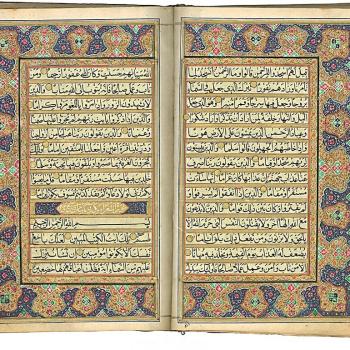
(Wikimedia Commons public domain image)
My introduction to volume 56 — volume 56! — of Interpreter: A Journal of Latter-day Saint Faith and Scholarship has now gone up online. And, as usual, it has gone up in a variety of formats, include audible (read by y’r obt’t servant with the expert technical assistance of Tom Pittman): “In This Batter’d Caravanserai,” written by Daniel C. Peterson
Abstract: In the Rubáiyát of Omar Khayyám, based upon verses composed by an eleventh-century Persian mathematician and astronomer, the English Victorian poet Edward FitzGerald eloquently portrays human life in an indifferent, deterministic universe that lacks any evident purpose and is bereft of divine Providence. The poem’s suggested response to such a universe is an unambitious life of hedonism, distraction, and gentle despair. It is curiously modern, and those considering the adoption of anything like its worldview might want to read it, and to think about its implications, very carefully.

Readers of 3 Nephi who, like me, favor a Mesoamerican model for the Book of Mormon, should need no reminding that Mesoamerica is a volcanically active area. But these photographs will serve, nonetheless, as a reminder: “Popocatépetl volcano spews smoke and ash, putting millions of Mexicans on alert”
Back now, though, to sharing notes from Robert J. Hutchinson, Searching for Jesus: New Discoveries in the Quest for Jesus of Nazareth — and How They Confirm the Gospel Accounts (Nashville: Nelson Books, 2015).
The French writer and historian Ernst Renan (1823-1892) was one of the pioneer writers (popularizers?) of the analysis of the historical Jesus along purely naturalistic lines. In his view, the resurrection of Christ was little more than the delusion experienced by some hysterical women when, shortly after the death and burial of Jesus, they were shocked by the discovery of an empty tomb.
The Anglican bishop William Temple is said to have quipped “Why anyone should have troubled to crucify the Christ of Liberal Protestantism has always been a mystery.” [William Temple, Readings in St. John’s Gospel (London: Macmillan, 1945], xxiv; quoted in James D. G. Dunn, Jesus Remembered (Grand Rapids, MI: Eerdmans, 2003), 49]
Here, first, is a passage about the history of the rationalist or liberal Protestant approach to life-of-Jesus research:
In his classic summary of (or eulogy for) the first quest, The Quest of the Historical Jesus, published in 1906, Dr. [Albert] Schweitzer concluded that the search for the historical Jesus had been an effort in which, in a sense, scholars peered down the long, dark well of history, and the image that they saw was nothing more than their own reflections looking back at them. “What [rationalism] is looking for is not the past, but itself in the past,” Schweitzer wrote. “For it, the problem of the life of Jesus is solved the moment it succeeds in bringing Jesus near to its own time, in portraying Him as the great teacher of virtue, and showing that His teaching is identical with the intellectual truth which rationalism deifies.”
A few years earlier, another scholar, Martin Kähler (1835-1912), had offered an even better reason for why the quest was doomed from the start: the historical sources available are simply not sufficient for the task at hand. If you reject the Gospels from the start as unreliable, and insist that Jesus must have been radically different from the way he is portrayed in the New Testament, then you simply don’t have enough information with which to construct a realistic portrait of Jesus of Nazareth, Kähler argued. “I regard the entire Life-of-Jesus movement as a blind alley,” he wrote. . . .
By the turn of the twentieth century, many of the leading theologians of Europe, such as Karl Barth and Rudolf Bultmann, would have agree with Kähler’s critique of the quest for the historical Jesus. They would insist that Christian faith is based on the kerygma, the proclamation of the church, and has little if anything to do with the tentative, uncertain research of academic history. The only Jesus people have access to, these theologians said, is the Jesus of the Gospels. Any other Jesus is just in the imagination of dreamy nineteenth-century rationalists such as Renan. (53, citing Albert Schweitzer, The Quest of the Historical Jesus, trans. W. Montgomery [London: Adam and Charles Black, 1911], 658, and Martin Kähler, The So-Called Historical Jesus and the Historic Biblical Christ, trans. Carl F. Braaten [Philadelphia: Fortress, 1964], 46)
On 1 February 2012, Daniel Wallace, director of the Center for the Study of New Testament Manuscripts at Dallas Theological Seminary, debated the famous agnostic New Testament scholar Bart Ehrman at Ehrman’s home institution, the University of North Carolina at Chapel Hill.
During his 2012 debate with Ehrman . . . Wallace pulled an ace out of his sleeve: he revealed that researchers associated with his Center for the Study of New Testament Manuscripts had recently discovered seven previously unknown New Testament papyri — six of which probably date from the second century (AD 100-200) and one probably from the first (that is, the seventies, eighties, or nineties). The fragments would be published at a future date, he said. If most scholars support the dating of these ancient fragments, this is a major discovery that could change, but will more likely reinforce, what historians already know about the writing of the Gospels.
According to Wallace, the discovery of these ancient papyri means that we now have eighteen New Testament manuscripts from the second century and one from the first. He estimates that more than 43 percent of all New Testament verses are found in just these eighteen early manuscripts. That would lend considerable weight to the argument that the official Greek text of the New Testament, relied upon for most modern Bible translations, is pretty close to the original.
The most startling of the recent discoveries, according to Wallace, is the first-century fragment; it is from the gospel of Mark, which is widely believed by scholars to be the very first gospel written. The earliest manuscript of Mark we currently have, called P45, is dated to around the year AD 250. Thus, this new find would predate P45 by 100 to 150 years. “It was dated by one of the world’s leading paleographers,” Wallace wrote two weeks after the debate. “He said he was ‘certain’ that it was from the first century. If this is true, it would be the oldest fragment of the New Testament known to exist.” (70-71, emphasis in the original; citing Daniel Wallace, “Earliest Manuscript of the New Testament Discovered?” Dallas Theological Seminary, 9 February 2012; https://voice.dts.edu/article/wallace-new-testament-manscript-first-century/)
And, in this next passage, Hutchinson makes what I consider a very important point:
Compared to other ancient writings, there exists an overwhelming volume of material and written “witnesses” to the New Testament text. Christian apologists have pointed out for decades just how few manuscript witnesses exist for other ancient writings. For example, we have only twenty manuscripts of the writings of Plato, with the earliest dating from the ninth century AD — or more than 1,250 years after they were written! We have only eight manuscripts from the writings of the Greek historian Thucydides, one of our principal sources for the history of ancient Greece; and only eight manuscripts of the Greek historian Herodotus, all of which date from the tenth century AD — or between 1,300 and 1,350 years after they were written. The same is true for most of our other sources for ancient history. We have only ten manuscripts of Julius Caesar’s Gallic Wars, dating from the tenth century, or 950 years after they were written; only twenty manuscripts of the writings of Tacitus, dating from AD 1100, or a thousand years after they were written; and only seven copies of Pliny the Younger’s History of Rome, dating from AD 850, or 750 years after it was written. In contrast, we have 5,800 manuscripts of the New Testament writings — some of which date to between fifty years (or less!) and three hundred years after the originals were first written. For example, if the gospel of John was written between AD 90 and 100, as many scholars believe, and the papyrus P52 dates to 125, then the copy we have was copied only twenty-five to thirty-five years after the gospel was originally written. That is a truly amazing chronological proximity to the original text!
Yet few ancient historians claim that we can’t be sure what Caesar, Tacitus, Herodotus, or Thucydides wrote, even though the earliest copies of their writings in existence date a thousand years or so after the original texts were written. There is very little discussion of copyist error in the case of Thucydides or Herodotus — even though the same dynamics were no doubt present with scribes who copied these works as with those who copied the gospels. There would be the same tendencies toward routine errors, spelling mistakes, dropped words, and the like; yet most historians rely upon these documents as reflecting, with reasonable accuracy, what the ancient writers actually wrote. By contrast, a rigorous standard of scrupulosity is commonly applied to the texts of the New Testament. (81-82, citing Joseph M. Holden and Norman Geisler, The Popular Handbook of Archaeology and the Bible [Eugene OR: Harvest House, 2013], 118-119, 129)
ETA: In response to this blog entry, Trevor Luke, an academic specialist on the history of ancient Rome, has written elsewhere to point out a couple of important errors in Robert Hutchinson’s passage above about Pliny the Younger and to note that Daniel Wallace has apparently backed off on the Markan fragment since his debate with Bart Ehrman. I appreciate the correction. One of my reasons for posting these notes is to garner helpful responses from readers. I’m gathering them for potential eventual use in future publications and, where possible, I hope to double- and triple-check every claim. I much prefer mistakes and misunderstandings to be identified prior to publication. I would rather not base my arguments on incorrect information or flawed analyses. So when others do some of my work for me, I’m grateful.












